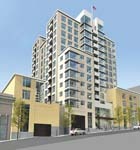Architect Larry Seaman is used to the challenges of building in a densely populated city. Currently, the partner at Christiani Johnson Architects is working on a new project in San Francisco that fits perfectly in his wheelhouse: a 13-story mixed-use building that meets the city’s strict planning requirements and the equally discerning tastes of Seaman’s environmentally conscious client, Gerding Edlen Development Company LLC. The new mid-rise features 12 stories of apartments over a retail level, and, working with Gerding Edlen, Seaman is designing the building to be maximally eco-conscious, even for a city where environmental awareness is the norm.
Christiani Johnson works primarily in the Bay Area, where both a dense population and a pervasive, aggressive culture of environmentalism have allowed the firm to build a portfolio that includes mostly LEED-certified or LEED-eligible buildings. The company’s project at 1285 Sutter Street—also aiming for LEED certification—is bounded by Sutter, Van Ness, and Hemlock streets and brings a new element to San Francisco’s Van Ness corridor. The building’s 205,000 square feet will contain two levels of underground parking, 10,000 square feet of retail space, and 107 apartment units. It’s slated for completion in June 2013, and it’s making a dramatic play for sustainability both on a grand scale and with its component parts.

Christiani Johnson Architects and developer Gerding Edlen are planning to incorporate a public energy-use dashboard and a solar hot-water system at 1285 Sutter Street.
Featuring a number of sweeping green technologies that meet or exceed LEED standards, the Sutter Street building’s most distinctive innovation is that its owner, Gerding Edlen, invested in an additional meter beyond what the electric company provides, allowing Gerding Edlen to monitor energy use in real time. Because the development firm manages several apartment complexes, the extensive energy measurements at 1285 Sutter Street will actually influence multiple buildings. “They’ll be able to use the data as both a comparison and a real-time warning,” Seaman says. “It can tell us if something’s amiss with the energy being used or if something is out of line with the norm on similar projects.” Gerding Edlen also hopes to make this more than just a hidden technology; the firm plans to install a dashboard display—separate from the retail space to keep residential readings accurate—in the lobby so that tenants also will be more conscious of their real-time energy use.
Seaman calls his client “exceptionally green-oriented” and says Gerding Edlen is also considering such innovations as a solar hot-water system—even though the square footage of the building isn’t large enough that the technology would pay for itself. Seaman says an urban mid-rise building offers a difficult footprint in terms of sustainability. But, he says, “We were able to get enough native vegetative materials to meet the LEED checkpoints. We’ve also established a few areas of green roof on the upper levels of the building.”
Seaman also is working closely with San Francisco’s planning commission to develop the strategies that will support the building’s sustainable design. Because the city’s environmentally conscious policies dictate much of area design, Seaman met with commissioners to ensure his building’s courtyard—which sits two levels above the street and requires raised planting—will meet code requirements and also have adequate room to support native plants and a cistern that will capture rainwater for irrigation.
As for the site-location and transportation sections of 1285 Sutter Street’s LEED checklist, Seaman anticipates these will be easily met. Christiani Johnson has long been committed to sustainability and environmental stewardship, and even as demands for green buildings grow, especially in urban areas, Seaman says his firm is ahead of the curve. “We’re trying to raise the standard of the projects in the corridor,” he says. And his project at 1285 Sutter Street is likely to do just that.

